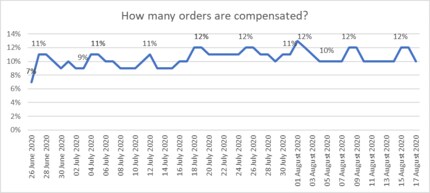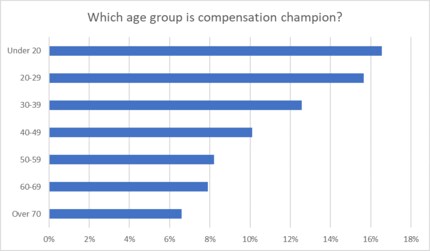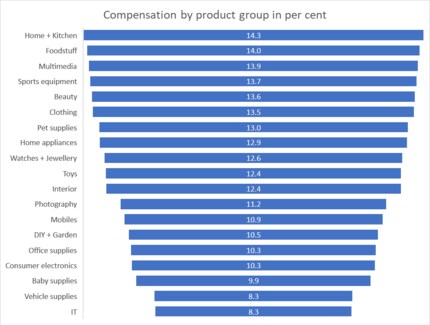
Company news
The digitec Galaxus community has invested 1.3 million Swiss francs in climate conservation
by Tobias Billeter

The climate compensation option has been really well received. Since mid-June, digitec and Galaxus customers have had the possibility to pay a voluntary fee to compensate the carbon emissions caused by their purchase. And they’re really making use of it. The carbon footprint of one in ten purchases has been neutralised since the launch of the option.
Mid-June saw the introduction of a new climate compensation feature at digitec and Galaxus. Since then, customers of both online shops have been able to make up for the carbon footprint left by their purchases by paying a voluntary fee. Prior to the introduction of this feature, digitec Galaxus asked 501 people in Switzerland if they’d be prepared to pay a voluntary environmental tax on their online shopping. Around 12 per cent answered «yes», 20 per cent said «probably yes» and 24 per cent were undecided. The remaining 44 per cent opposed to the option.
Now it appears that people who gave a positive answer in the survey have put their words into action. After a solid month since the launch, exactly ten per cent of purchases at digitec and Galaxus have been compensated. And the trend is rising. In June, 7.4 per cent of customers clicked on the green button to compensate their shopping; by the end of July, the number had risen to 12 per cent. This corresponds to 7,300 tonnes of carbon emissions. At present, the compensation is stabilising at around ten per cent. By mid-August, over 150,000 francs had already gone towards selected climate projects.

Which age group compensates the most? The compensation champions are the under 20-year-olds: over 16 per cent of them make use of the CO2 option at the checkout page. The youngest age group is closely followed by the 20–29-year-olds (15.7%) and the 30–39-year-olds (12.6%). In the aforementioned survey, senior customers proved to be less generous. This is also reflected in real life. With increasing age, the willingness to make a donation decreases. However, it should be pointed out that the under-40s also make up the largest customer group.

At the top of the list of compensated products are household appliances (14.3%), followed by food (14%) and multimedia such as books, films and music (13.9%). Consumers were proportionally the least likely to click on the climate compensation button for IT products.

The amount of the compensation charge proved to be a decisive factor according to the survey. 27 per cent of participants said they’d be unwilling to make a contribution, 15 per cent said they would contribute if the amount was less than one per cent of the purchase value, and 21 per cent said they’d be willing contribute between one and two per cent of the total costs.
The average compensation amount is 1.30 francs. This is perfectly acceptable to most. To date, 94 francs has been the highest amount donated for an order.
Basel-based customers compensate 12.6 per cent of their purchases; customers in Zurich make up for 12 per cent and Berne-based buyers pay for 11.9 per cent of their shopping. In French-speaking Switzerland, Neuchâtel is the leader with 11 per cent.
On average, people in German-speaking Switzerland compensate for slightly fewer purchases (9.7 %) than those in French-speaking Switzerland (9.9 %). However, there’s no clear divide between the two regions. Similarly, there’s not much of a difference between urban and rural areas. Although the city-shaped cantons of Basel-Stadt and Zurich lead the ranking, they’re closely followed by the cantons Appenzell Ausserrhoden in sixth place and Grisons in seventh. The urban canton of Geneva ranks quite low in 15th place. In Appenzell Innerrhoden, customers compensate the least at 7.8 per cent.

In the survey, more women than men stated that they’d compensate for their purchases. In reality, however, there is no significant difference. 11.2 per cent of men and 11.4 per cent of women clicked on the green option. In other words, there can be no question of gender difference.
If the compensation trend continues, over 25,000 tonnes of CO2 will be compensated by the end of this year. «That’s roughly what we expected. Internal surveys revealed big differences. The estimates ranged from one to twenty per cent. Surveys add to the uncertainty, as people tend to present themselves in a better light,» says Oliver Herren, CIO of Digitec Galaxus. «By introducing the climate compensation option, we’re giving our customers the opportunity to decide what’s important to them. This is in line with our goal of creating transparency for our customers so they can make conscious purchasing decisions.»
I'm passionate about my job as a PR story writer. I've always been fascinated by advertising, magazines and media products of all kinds – from trashy Britney to highly intellectual Judith Butler. When I'm not at work, I enjoy spending time sharpening my critical view of society and deconstructing clichés. Nothing's more unneccessary to me than falling back into outdated role models again and again.
Everything you'd usually read on a news portal or in the newspaper can be found here, directly from the source: annual figures, new services, our efforts for greater sustainability, sales trends and so on.
Show all